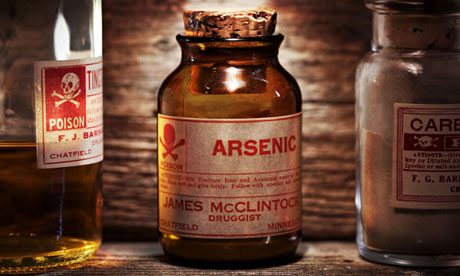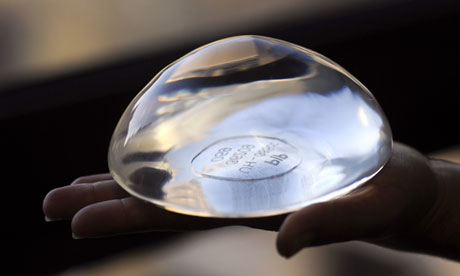
Arsenic – fancy a pint? Photograph: Alamy
Since the horse meat scandal, more of us than ever before are holding a microscope up to what we eat. But no matter how many labels you read, you could still be consuming things you'd rather put on your "do not eat" list. From human hair in our bread to fish bladder in our beer, there are a lot of additives and food processing techniques that employ ingredients and chemicals few would classify as "appetising". It's a reminder, frankly, that non-processed foods are your best bet.
Arsenic
Traces of arsenic in food are nothing new. The potent human carcinogen arsenic has been known to turn up in everything from rice to cereal to juice, and most recently German researchers found traces of it in beer, noting some levels found were more than twice than what is allowed in drinking water. Traces of arsenic can actually be found in both beers and wine that are clearer in colour. That's because they will have been filtered to get rid of plant matter and leftover yeast; most people don't want to drink a cloudy pinot grigio after all. To filter, beer and winemakers use diatomaceous earth, a natural product that contains iron and metals; hence the arsenic. Want less arsenic in your drink? Opt for drinks that are unfiltered.
Human hair
Amino acids are your body's building blocks, and while they can be good for your health, not all amino acids are created equal. L-Cysteine – an amino acid used to prolong shelf-life in products such as commercial bread – can be found in duck and chicken feathers and cow horns, but most that's used in food comes from human hair. It has been reported that most of the hair used to make L-Cysteine comes from China, where it's gathered from barbershops and hair salons. You can avoid L-Cysteine by buying fresh bread from a local baker, as it is not an additive in flour. Steer clear of fast food places such as McDonald's, Dunkin' Donuts and Burger King too, who all use L-Cysteine as an additive.
 Human hair … in bread? Photograph: Romilly Lockyer/Getty Images
Human hair … in bread? Photograph: Romilly Lockyer/Getty ImagesAntifreeze
You're not drinking straight antifreeze when you down a soft drink, but if your drink of choice has propylene glycol in it you're consuming a compound that's used for everything from antifreeze to cosmetics to pharmaceuticals to electronic cigarettes. Its properties are many, so it's no surprise that chemical companies such as DOW get excited about its potential in the corporate food world. It's also a minor ingredient in Corexit, the oil dispersant that was used after the Deepwater Horizon oil spill. Fortunately, if you live in the European Union, propylene glycol is not cleared as a general-purpose food grade product or direct food additive.
Beaver anal glands
If you're eating vanilla, strawberry or raspberry ice-cream, you may just be eating beaver's anal and urine secretions. Castoreum, which comes from the castor sacs of male and female beavers, is an FDA-approvedfood additive popular in ice-creams, and allowed to be called "natural flavouring", meaning you probably don't know that you are eating it.
 Fancy an ice-cream? Photograph: Juniors Bildarchiv/Alamy
Fancy an ice-cream? Photograph: Juniors Bildarchiv/AlamyFish bladder
A round of beers may sound like the perfect way to celebrate with vegetarian and vegan friends alike, but watch what beer you're drinking. Isinglass is a gelatin-like substance produced from the swim bladder of a fish. It's added to cask beers and Guinness, to help remove any "haziness" from the final product - removing any residue yeast or solid particles in the beer – which means you could end up with a trace of fish bladder in your pint glass.
Coal tar
Many processed foods are known for including a long list of dyes, and many of those dyes are derived from coal tar. Yellow #5, also known as tartrazine, was linked to childhood hyperactivity in 2007 and since then any product in the EU that contains it must also come with a warning label. In the US, however, there is no such regulation. Concern over the food colouring recently prompted bloggers to petition Kraft to remove the dyes from their popular macaroni cheese product.
 What's in your nuggets? Photograph: Anne-Christine Poujoulat/AFP/Getty Images
What's in your nuggets? Photograph: Anne-Christine Poujoulat/AFP/Getty ImagesSilicone breast implant filler
Chicken McNuggets from McDonald's aren't known for being the healthiest thing on the planet, but they're not really known for being "chicken" either. The nuggets are actually only about 50% actual chicken; the rest comprises synthetic ingredients, including dimethylpolysiloxane, a chemical used in silicone that can be found inSilly Putty as well as breast implant filler.
Boiled beetle shells
Natural Red #4 may sound harmless, but the food colouring – also known as carmine – is made by boiling female cochineal insect shells in ammonia or a sodium carbonate solution. It takes about 70,000 of the bugs to produce one pound of dye. Coffee giant Starbucks got slammed in 2012 for using the additive in their frappuccinos and eventually binned it, but it's a commonly employed ingredient in many foods. TheEuropean Food Standards Authority recently included it as an additive to research more. But while some may feel queasy at the thought of consuming bugs, the synthetic alternatives to this natural dye, such as Red #2 and Red #40, are made from petroleum products. Pick your poison.
Rodent hair
Producing food products in an industrial facility is nothing like cooking at home, and certainly a big warehouse space is sure to be home to a few rodents here and there. Maybe that's why the US FDA allows for certain amounts of rodent hair in various products, something they call an "unavoidable defects": one rodent hair for every 100g chocolate, 22 rodent hairs for every 100g cinnamon and five rodent hairs for every18oz jar of peanut butter. Yum.
Borax
Banned in the US and Canada as a food additive but allowed in the EU, borax is also known for making its way into fire-retardant, anti-fungal compounds and enamel. E285, as it's known in the food world, is used to control acidity in products as well as assist in preservation. You'll find it in some caviars – including those imported to the US – as well as various Asian noodle and rice dishes as it adds a firm, rubbery texture to foods.
So. Any more for any more?
Originally Posted On: http://www.guardian.co.uk/lifeandstyle/wordofmouth/2013/may/13/10-gross-ingredients-food-horsemeat-scandal?CMP=twt_fd









